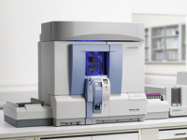Featured Article

Please check out our Hematology Analyzers section for more information or to find manufacturers that sell these products.
Some form of electronic hematology analyzer is found at the center of most clinical laboratories. A blood cell count is usually the first screening test used to assess general health, rule out anemia or infection, and monitor cancer patients during the course of chemotherapy. It is difficult to imagine medical care without this workhorse device, and surprising to learn its origins.
Early testing of sonar, developed to detect submarines during World War II, revealed odd underwater echoes. To determine the cause, an electrical engineer was tasked with counting plankton in a large number of seawater samples. He devised a dual-chamber container whose two sides were separated by a thin membrane fashioned from a cellophane cigarette carton wrapper. Having set up an ohm meter to measure impedance across the orifice, he partially drained one chamber. As seawater flowed through the orifice, each plankton cell caused a momentary drop in impedance. In this way, the concentration of plankton particles could be measured. The odd echoes were attributed to plankton, the principle was patented, and the practice of hematology was revolutionized.
All modern hematology analyzers, whether they are top-of-the-line models or the simple hematology analyzers used in physician's office laboratories, depend on electrical impedance to classify and count red and white blood cells based on their size. Improvements to the application of electrical impedance include pulse editing, which corrects for cells passing through the aperture at various angles or at the same instant.
Cell counters must be sophisticated in the complexities of liquid handling; their fluidics systems must deliver exquisitely precise volumes of sample, diluent, and reagents by means of tubing and valves. Early instruments measured volumes using a mercury manometer. Fluidics were improved in later models by introduction of vacuum pump systems. Today's instruments, such as the Horiba ABX Micros 60 (Irvine, CA), deliver liquids using calibrated syringes, resulting in more reliable performance, less down time, and simpler repairs.
Visible wavelength light is passed through the sample stream in even the simplest modern hematology analyzers. In most cell counters, the resulting light scatter is used to classify cells by granularity. Visible wavelength light is also used to improve counting of platelets, which are difficult to count because of their variable size and tendency to aggregate. In more sophisticated analyzers, dual-angle optical scatter analysis combines optical signals from two independent light sources, eliminating common interferences in platelet counting. In the case of the Abbott CELL-DYNE Sapphire (Abbott Park, IL), the dual-angle optical platelet count is then validated internally by an impedance count to identify possible interferences.
Newer technologies are incorporated in the more sophisticated cell counter models, improving the accuracy of the automated white blood cell (WBC) differential count and enabling further classification of atypical or immature cells. Some hematology analyzers now use flow cytometry labels, lasers, and detectors to distinguish cell populations. This powerful technique classifies immature or atypical cells, which can have deceptively similar appearance in stained blood films, based on known cell-surface markers. Because the number of cells counted by an automated system is many times greater than the number countable by eye in a manual differential, and because of the specificity of the cell-surface marker labels, the automated cell differential maximizes accuracy in hematology analysis.
A variety of other innovations in hematology analyzers include automated multi-sample loading, closed-tube sampling, bar-code sample identification, automated preparation of stained or unstained blood smears, and a variety of data management and reporting systems. Analyzers can store weeks or months of patient data, retrieve them in a variety of report forms, or communicate with a host over a serial link. Quality control data management is offered in even the simplest cell counters, with programs ranging from basic QC data retrieval and analysis to Internet-based real-time data-sharing systems. Beyond improving user safety and convenience, these capabilities can shorten turnaround time, provide real-time quality control information, and reduce clerical errors in data reporting.
One form of innovation is the miniaturization of an existing platform. In 2010, Horiba announced the release of the Pentra C200, a compact, plug-and-play analyzer that deploys many of the same pumping and analysis capabilities of the larger aforementioned ABX 60.
A broad range of hematology analyzers is available today, and there is a powerful and reliable instrument capable of meeting the needs of every type of clinical laboratory. The modern cell counter combines a variety of technologies, simple and sophisticated, old and new, enabling laboratories to provide fast, reliable information for screening, diagnosis, and monitoring the health of every patient.
Betsy Donnelly has 30 years of experience as technologist, scientist, and manager in clinical laboratory medicine and biotechnology.
Please check out our Hematology Analyzers section for more information or to find manufacturers that sell these products.